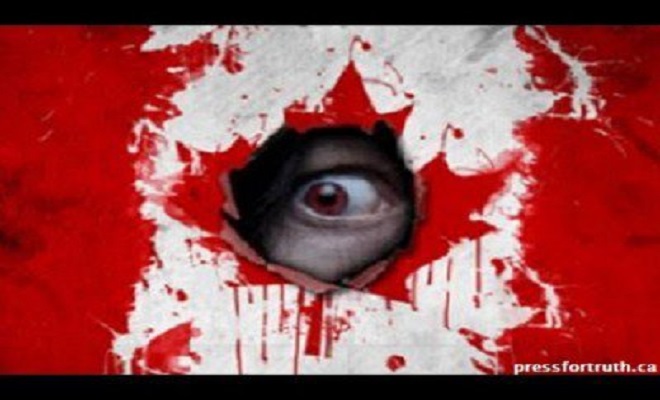 Global Research
Global Research
NWO
Threat to Canadian Democracy: “Anti-Terror Act” isn’t about Terrorism
Harper Government’s “Anti-Terrorism Act” isn’t about Terrorism, it’s a Torture Act
by Michael Keefer, via Global Research.ca:
The Harper government’s Bill C-51, or Anti-Terrorism Act, has been in the public domain for over a month. Long enough for us to know that it subverts basic principles of constitutional law, assaults rights of free speech and free assembly, and is viciously anti-democratic.
An unprecedented torrent of criticism has been directed against this bill as the government rushes it through Parliament. This has included stern or at least sceptical editorials in all the major newspapers; an open letter, signed by four former Prime Ministers and five former Supreme Court judges, denouncing the bill for exposing Canadians to major violations of their rights; and another letter, signed by a hundred Canadian law professors, explaining the dangers it poses to justice and legality.
As its critics have shown, the bill isn’t really about terrorism: it’s about smearing other activities by association—and then suppressing them in ways that would formerly have been flagrantly illegal. The bill targets, among others, people who defend the treaty rights of First Nations, people who oppose tar sands, fracking, and bitumen-carrying pipelines as threats to health and the environment, and people who urge that international law be peacefully applied to ending Israel’s illegal occupation of Palestinian territories. (Members of this latter group include significant numbers of Canadian Jews.)
But the Anti-Terrorism Act is more mortally dangerous to Canadian democracy than even these indications would suggest. A central section of the act empowers CSIS agents to obtain judicial warrants—on mere suspicion, with no requirement for supporting evidence—that will allow them to supplement other disruptive actions against purported enemies of Harperland with acts that directly violate the Charter of Rights and Freedoms and other Canadian laws.
The only constraints placed on this legalized law-breaking are that CSIS agents shall not “(a) cause, intentionally or by criminal negligence, death or bodily harm to an individual; (b) wilfully attempt in any manner to obstruct, pervert or defeat the course of justice; or (c) violate the sexual integrity of an individual.”
The second of these prohibitions—occurring in the midst of a bill that seeks systematically to obstruct citizens in the exercise of their rights, pervert justice, and defeat democracy—might tempt one to believe that there is a satirist at work within the Department of Justice. (Note, however, that CSIS agents can obstruct, pervert and defeat to their hearts’ content, so long as they do so haphazardly, rather than “wilfully.”)
But the first and third clauses amount to an authorization of torture.
On February 16, Matthew Behrens observed that these clauses recall “the bone-chilling justification of torture” in the infamous memos of George W. Bush’s Justice Department. He pertinently asked what the Canadian government knows, if it “actually feels the need to spell out such a prohibition, […] about illicit CSIS practices behind closed doors….”1 On February 17, two prominent legal experts, Clayton Ruby and Nader R. Hasan, remarked that the “limited exclusions” in these clauses “leave CSIS with incredibly expansive powers, including water boarding, inflicting pain (torture) or causing psychological harm to an individual.”2
Like the Bush torture memos, Harper’s Anti-Terrorism Act is attempting to legitimize forbidden practices. Bush’s lawyers argued that interrogation methods producing pain below the level of “organ failure, impairment of bodily function, or even death” were legal—as were methods producing purely mental suffering, unless they resulted in “significant psychological harm […] lasting for months or even years.”3 Harper’s legislation prohibits acts of the kind that created an international scandal when the torture practices of Abu Graib, Bagram and Guantánamo became public. But as Ruby and Hasan recognize, in so doing it is tacitly declaring acts of torture that fall below that horrifying threshold to be permissible.
Most of the torture methods applied in the black sites of the American gulag during the so-called War on Terror would be permitted to CSIS under Harper’s Anti-Terrorism Act. Among these methods are sleep deprivation and sensory deprivation (both of which induce psychosis, without of course leaving physical marks), stress-position torture and waterboarding (which again leave no marks of “bodily harm”), and techniques of beating and pressure-point torture that produce excruciating pain without leaving visible traces.4
As to what CSIS does behind closed doors, we know enough to be able to say that this agency is already seriously off its leash. CSIS agents were involved in interrogating Afghan prisoners from early 2002 until 2007 or later, a period during which the American and Afghan agencies with which they collaborated were systematically torturing detainees. We know from journalists Jim Bronskill and Murray Brewster that one of the Kandahar interrogation sites used by CSIS, “work[ing] alongside the American CIA and in close co-operation with Canada’s secretive, elite JTF-2 commandos,” was a “secluded base”—this seems a polite way of saying ‘secret torture facility’—“known as Graceland.”5
American torturers seem to have enjoyed giving names of this sort to their black sites: the secret facility outside the Guantánamo prison where three prisoners were tortured to death on the night of June 9, 2006 is called “Penny Lane.”6 (Think about the lyrics to Paul Simon’s “Graceland” and the Beatles’ “Penny Lane”: you’ll understand that these interrogators are sick puppies indeed.)7
But these are the people that Jack Hooper, Assistant and then Deputy Director of CSIS Operations from 2002 until 2007, wanted his agents to emulate. He told his men, “If you’re going to run with the big dogs, you’d better learn to piss in the high grass.”8
We know already that Stephen Harper doesn’t flinch from covering up high-level Canadian responsibility for torture in Afghanistan. In November 2009, the Toronto Star quoted a former senior NATO public affairs official as saying that flagrantly false denials about Canadian complicity in the torture of Afghan detainees had been scripted by Harper and his PMO, “which was running the public affairs aspect of Canadian engagement in Afghanistan with a 6,000-mile screwdriver.”9 And we’ve not forgotten that a month later Mr. Harper prorogued Parliament in order to shut down a parliamentary committee that was hearing evidence on the subject.
But on October 22 of last year, when a deranged gunman murdered Corporal Nathan Cirillo at the National War Memorial and then tried to run amok on Parliament Hill, Mr. Harper was less brave. While some members of his caucus prepared to defend themselves and their parliamentary colleagues with anything that came to hand, he hid in a closet.
It seems that Mr. Harper would now like us all to share the emotion he felt in that closet—if not by quivering at the mention of ISIS jihadis, then, soon enough, by shaking in our boots at the thought of CSIS toughs kicking down doors at midnight.
Canadians need to tell this government, and this prime minister, that we are not intimidated on either count.
We are ashamed by his lies over high-level Canadian complicity in torture in Afghanistan.
We will not tolerate his attempt to institutionalize torture in Canada.
Read More @ Global Research.ca












